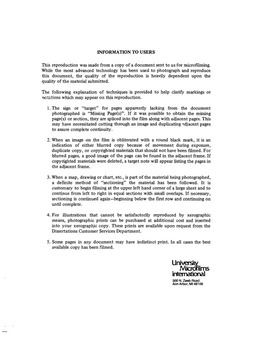| dc.contributor.author | Anderson, Charles Austin, | en_US |
| dc.date.accessioned | 2013-08-16T12:28:52Z | |
| dc.date.available | 2013-08-16T12:28:52Z | |
| dc.date.issued | 1983 | en_US |
| dc.identifier.uri | https://hdl.handle.net/11244/5105 | |
| dc.description.abstract | Much of the anthropological work on Middle American communities has generally typified local (community) informal law as "customary". The emphasis on only one type of dispute resolution agency obfuscates definitive conclusions in clarifying the complex juridical characteristics of Middle America. This complexity can be illuminated and made more lucid through a comparative analysis of de facto and de jure methods of conflict resolution. Therefore, this research was undertaken as an analysis and critique of the ethnographic literature in depth. These sources were treated as an ethnohistorian explores any historical documentation. | en_US |
| dc.description.abstract | Ancillary to these points, in the areas of Middle America where governmental integration has been rapid and pervasive, the adoption of formal conflict resolution methods has been practically complete. | en_US |
| dc.description.abstract | Through the utilization of the 1917 Mexican Constitution and the basic statutory law derived therefrom as a model, the thrust of the research is to demonstrate that, despite many contentions about standardized group or class practices or behavior patterns entering into decisions pertaining to the resolution of disputes, enacted statutory law also plays a vital role (more than many anthropologists are ready to admit) in the areas surveyed. | en_US |
| dc.description.abstract | This exhaustive study has substantiated three basic points, namely: (1) Enough data was presented to support the hypothesis that the indigenous conflict resolution systems of Middle America have in measurable degree been adopted from, rather than adapted to, the Hispano-Roman derived systems of social control employed at the Federal and State levels. (2) The resolution of village conflicts through the utilization of formal judicial mechanisms is only one factor in influencing ethnic boundaries and the motivation and efforts to maintain a degree of ethnic autonomy are seen not merely as attempts to maintain separateness between local community and State; but, also, between local communities. (3) As one progresses or advances from the local levels to more remote areas of State control, little difference can be perceived in the degrees of adoption of de jure control mechanisms. | en_US |
| dc.description.abstract | No attempts have been made to evaluate the relationships between the dispositions of recurrent conflict situations existing at the village level to ascertain whether or not the de facto conflict resolution is more functional than the official institutions (de jure) in a complex of cultures that are represented by the Nation-States of Middle America. | en_US |
| dc.format.extent | ix, 284 leaves ; | en_US |
| dc.subject | Anthropology, Cultural. | en_US |
| dc.title | The anthropology of law : | en_US |
| dc.type | Thesis | en_US |
| dc.thesis.degree | Ph.D. | en_US |
| dc.thesis.degreeDiscipline | Department of Anthropology | en_US |
| dc.note | Source: Dissertation Abstracts International, Volume: 44-02, Section: A, page: 0524. | en_US |
| ou.identifier | (UMI)AAI8314755 | en_US |
| ou.group | College of Arts and Sciences::Department of Anthropology | |
